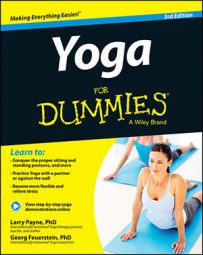If shallow or erratic breathing puts your well-being at risk, the complete yogic breath is your ticket to excellent physical and mental health. If you do no other Yoga exercise, the complete Yoga breath — integrally combined with relaxation — can still be of invaluable benefit to you. It’s your secret weapon, except that Yoga doesn’t advocate the use of force.
Belly breathing
Before you jump into practicing the complete yogic breath, try out this exercise:
Lie flat on your back, and place one hand on your chest and the other on your abdomen.
Place a small pillow or folded blanket under your head if you have tension in your neck or if your chin tilts upward. Place a large pillow under your knees if your back is uncomfortable.
![[Credit: Photograph by Adam Latham]](https://www.dummies.com/wp-content/uploads/431528.image0.jpg) Credit: Photograph by Adam Latham
Credit: Photograph by Adam LathamTake 15 to 20 slow, deep breaths. During inhalation, expand your abdomen; during exhalation, contract your abdomen but keep your chest as motionless as possible.
Your hands act as motion detectors.
Pause for a couple seconds between inhalation and exhalation, keeping the throat soft.
Belly-to-chest breathing
In belly-to-chest breathing, you really exercise your chest and diaphragm muscles as well as your lungs, and you treat your body with oodles of oxygen and life force (prana). When you’re done, your cells are humming with energy and your brain is grateful to you for the extra boost.
You can use this form of breathing before you begin your relaxation practice, before and where indicated during your practice of the Yoga postures, and whenever you feel so inclined throughout the day. You don’t necessarily have to lie down; you can be seated or even walking. After practicing this technique for a while, you may find that it becomes second nature to you.
Lie flat on your back, with your knees bent and your feet on the floor at hip width, and relax.
Place a small pillow or folded blanket under your head if you have tension in your neck or if your chin tilts upward. Place a large pillow under your knees if your back is uncomfortable.
Inhale while expanding your abdomen, your ribs, and then your chest; pause for a couple seconds.
Exhale while releasing your chest and shoulder muscles, gently and continuously contracting or drawing in your abdomen; pause again for a couple seconds.
Repeat Steps 2 and 3 from 6 to 12 times.
![[Credit: Photograph by Adam Latham]](https://www.dummies.com/wp-content/uploads/431529.image1.jpg) Credit: Photograph by Adam Latham
Credit: Photograph by Adam Latham
You can greatly enhance the value of this exercise by fully participating with your mind. Feel the air fill your lungs. Feel your muscles work. Feel your body as a whole. Visualize precious life energy entering your lungs and every cell of your body. To help you experience this exercise more profoundly, keep your eyes closed. Place your hands on your abdomen and feel it expand upon inhalation.
Chest-to-belly breathing
Classically, yoga teachers taught yogic breathing from the abdomen up on inhalation, which you can see in numerous publications on Yoga. This method works well for many people. However, in the 1960s, Yoga master T.K.V. Desikachar, with the guidance of his father, the late T. Krishnamacharya, began to adapt the traditional yogic breathing to the needs of Western students.
Think about it: Folks in the West sit in chairs and bend forward too much. The daily sitting routine begins in the early morning when they go to the bathroom and then lean over the sink to brush their teeth and do whatever else they do to their faces.
They sit at the breakfast table and then again while they commute to their workplaces, where they clock a lot more time sitting and slouching in front of a computer or typewriter or bending over a machine. Finally, in the evening, they go home and sit down for dinner; afterward, perhaps, they sit in front of the television or their computer until their eyes get blurry.
The chest-to-belly breathing emphasizes arching the spine and the upper back to compensate for all this bending forward throughout the day, and it also works well for moving into and out of Yoga postures. Chest-to-belly breathing is also an excellent energizer in the morning; you can do it even before you hop out of bed. This exercise shouldn’t be done late at night because it’s likely to keep you awake.
The following exercise complements the belly-to-chest breathing technique. As with that technique, you can practice the following exercise lying down, seated, or even while walking.
Lie flat on your back, with your knees bent and your feet on the floor at hip width, and relax.
Place a small pillow or folded blanket under your head if you have tension in your neck or if your chin tilts upward. Place a large pillow under your knees if your back is uncomfortable.
Inhale while expanding the chest from the top down and continuing this movement downward into the belly; pause for a couple seconds.
![[Credit: Photograph by Adam Latham]](https://www.dummies.com/wp-content/uploads/431530.image2.jpg) Credit: Photograph by Adam Latham
Credit: Photograph by Adam LathamExhale while gently contracting and drawing the belly inward, starting just below the navel; pause for a couple seconds.
Repeat Steps 2 and 3 from 6 to 12 times.

